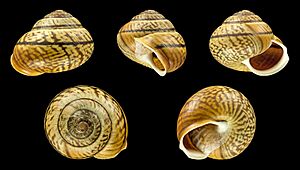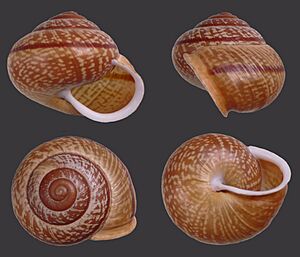Arianta arbustorum facts for kids
Quick facts for kids Arianta arbustorum |
|
|---|---|
 |
|
| Shell of Arianta arbustorum (syntype at MNHN, Paris) | |
| Conservation status | |
| Scientific classification | |
| Genus: |
Arianta
|
| Species: |
arbustorum
|
| Synonyms | |
|
|
The copse snail, also known by its scientific name Arianta arbustorum, is a medium-sized land snail. It's a type of snail that breathes air, just like us! This snail belongs to the family called Helicidae.
Contents
Different Types of Copse Snails
Sometimes, animals of the same species can have slightly different groups. These groups are called subspecies. They might look a bit different or live in specific areas.
Here are some recognized subspecies of the copse snail:
- Arianta arbustorum alpicola
- Arianta arbustorum arbustorum
- Arianta arbustorum canigonensis
- Arianta arbustorum picea
- Arianta arbustorum pseudorudis
- Arianta arbustorum repellini
- Arianta arbustorum styriaca
- Arianta arbustorum vareliensis
Where Do Copse Snails Live?
The copse snail is originally from many parts of Europe. You can find it across north-western and central Europe. This includes places like the Netherlands, Austria, Czech Republic, Slovakia, and Poland.
European Homes
In Switzerland, the copse snail is very common. You might find up to 20 adult snails in just one square meter! It also lives in the eastern Pyrenees in Spain, and in northern countries like Norway, Iceland, and the Faroe Islands.
In the British Isles (Great Britain and Ireland), the snail has faced some challenges. This is due to modern farming and the loss of natural areas where it likes to live. It is quite rare in Ireland.
The copse snail is also found in Kaliningrad, Estonia, and Latvia. In Finland, especially near Porvoo, it's so common that people sometimes call it the "Porvoo snail"! You can also find it scattered in Serbia, Bulgaria (where it's rare), and western Ukraine.
Journey to North America
Arianta arbustorum has also traveled to North America. It has established populations in parts of Canada. These include Newfoundland, New Brunswick, Ontario, and Prince Edward Island.
Why Some Countries Are Concerned
This snail has not yet become common in the United States. However, experts see it as a potential invasive species. An invasive species is an animal or plant that spreads to a new area and can cause harm. This harm might be to farms, natural places, or businesses. Because of this, some suggest that the copse snail should be a top concern for quarantine in the USA. Quarantine means keeping something separate to prevent it from spreading.
What Does a Copse Snail Look Like?
The copse snail's shell is usually brown. It often has many pale yellowish spots in rows. You might also see a brown band around the middle of the shell. Sometimes, the shell can be yellowish, reddish, or have a greenish tint.
Shell Features
The shell has fine lines and is slightly bumpy. It has about 5 to 5.5 rounded whorls. These are the spiral turns of the shell. The lines between the whorls, called sutures, are quite deep. The last whorl, which is the largest, curves down a little near the opening.
The opening of the shell, called the aperture, has a noticeable white edge inside. This edge is also slightly turned outwards. The central hole on the underside of the shell, called the umbilicus, is completely covered by the shell's edge.
Size and Shape
The shell is usually about 18 to 25 millimeters wide. It is about 12 to 22 millimeters tall. The exact size can change depending on where the snail lives.
Most copse snails today have a round, globe-like shell. However, scientists believe that long ago, during the Pleistocene Ice Age, their shells were flatter. As they moved into new areas, their shells became more rounded.
The snail's body is usually black.
Life of a Copse Snail
Copse snails live in many different places. You can find them in forests and open areas. They need a lot of moisture to survive. They can also live in places that have been disturbed by humans. In the Alps, they can live at very high altitudes, up to 2700 meters!
What They Eat
These snails are not picky eaters. They feed on green plants, but they also eat dead animals and even animal waste.
How They Move and Grow
Copse snails don't travel very far. They usually move about 7 to 12 meters in a year. They often follow water currents. If two snails are more than 50 meters apart, they are considered isolated. This means they probably won't meet each other.
During mating, copse snails use special structures called love darts. These are small, sharp, calcium-filled darts. Snails usually reproduce after mating with another snail. However, they can also reproduce by themselves, which is called self-fertilization.
A copse snail egg is about 3.2 millimeters in size. Snails become adults and can reproduce after 2 to 4 years. They can live for a long time, sometimes up to 14 years!
How to Manage Snails
People sometimes use certain methods to control snail populations. Metaldehyde and iron phosphate are chemicals that can be used to get rid of snails. Another interesting method is using copper. Copper creates small electric shocks that make it hard for snails to move across it. This makes copper a good material for creating barriers to keep snails out of certain areas.





